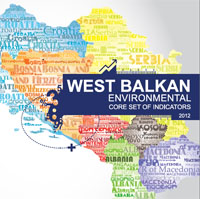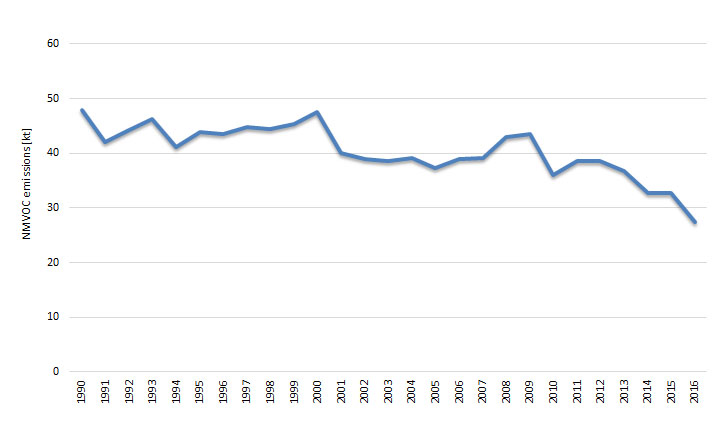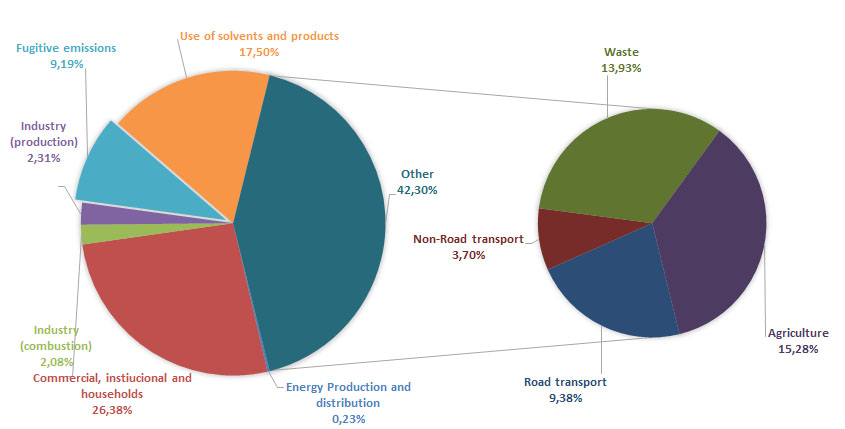| EMMISSION OF THE MAIN POLLUTING SUBSTANCES – EMISSION OF NON-METHANE VOLATILE ORGANIC COMPOUNDS (NMVOC) |
The indicator tracks the trends innon-methane volatile organic compounds (NMVOC).
kt (kilotons per year)
What progress has been made in overall reduction of emissions of non-methane volatile organic compounds in the Republic of Macedonia?
In 1990, the total national emissions of NMVOC amounted to about 44 kt. In 2016 for comparison, the emissions are reduced to around 27,3 kt, which is a decrease of 43%. The reasons for the decline are mainly in lower emissions from transport, the use of solvents and industrial processes. From 2015 to 2016 emissions were reduced by 16%, due to reduced emissions from other sectors (use of solvents, households) by 21% and industrial processes by 39%.
The Diagram below shows the annual trend in the emissions of non-methane volatile organic compounds for the period 1990 to 2016.
Diagram 1.Trend in emissions of non-methane volatile organic compounds
Under the CARDS Programme, Inventory of air emissions of the main pollutants in the country was established in 2005 in accordance with the EMEP methodology by individual sectors, i.e. activities, and in 2014, the Inventory including all pollutants was prepared.Starting from 2014, the Republic of Macedonia carries out calculations of national emissions for all pollutants.
The emission sources, within this national indicator, are made according to the following categorization:
| Sector |
| Energy Production and distribution |
| Commercial, institutional and households |
| Industry (combustion) |
| Industry (production) |
| Fugitive emissions |
| Use of solvents and products |
| Road transport |
| Non-Road transport |
| Waste |
| Agriculture |
| Other |
The main sources of emissions in 2016 for NMVOCs are the following sectors: Commercial, institutional and households (mainly household heating) and use of solvents and products that have a share of 26,4% and 17.5%, respectively, in the total national emissions of NMVOC. The emissions of NMVOC from the sector agriculture, mainly derived from agricultural land, have a share of 15,3% in total national emissions. Contribution to the total emissions of NMVOC results also from Waste, with a share of 13,9%, 9,4% of the total emissions of NMVOC derive from Road transport, while Fugitive emissions participates with a share of 9,2%.
Diagram 2. Emissions ofNMVOCsbysectors in 2016
Which different sectors and processes contribute to non-methane volatile organic compounds emissions?
The main sources of emissions in 2016 of NMVOCs are NFR categories of sources 1A4 – Other sectors (mainly household heating), 2 – Industrial processes and use of products (mainly solvent use), 3 – Agriculture, 5 – Waste, 1A3 – Transport and 1B – Fugitive emissions (mainly from extraction and distribution fossil fuels and geothermal energy)with shares of 29%, 20%, 15%, 14% and 9% respectively. In the period 2011-2013, the annual emissions of NMVOC by sectors are approximately the same, so that in 2014 and 2015 their emission reduction is registered due to the reduction of NMVOC emissions from the NFR categories 2 – Industrial processes and 1A4 – Other sectors (mainly household heating). Another significant reduction in NMVOC emissions is in 2016, primarily due to the further reduction of emissions from the NFR categories 2 – Industrial processes and 1A4 – Other sectors.
Diagram 3. Emissions of NMVOCs by NFR sectors per year
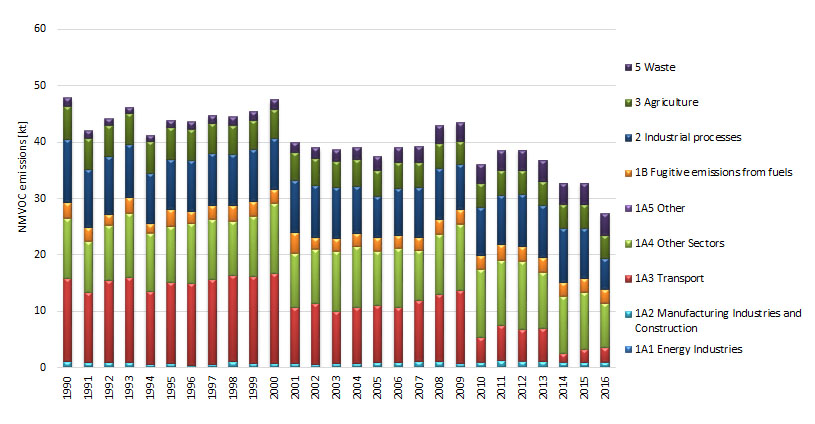 Data coverage: excel_1, excel_2
Data coverage: excel_1, excel_2
Sources of data: The data used refers to overall national emissions and emissions categorized by NFR delivered by EEA member and collaborating states to EEA and Secretariat of the United Nations. Data is accessible per country on the following web address: http://cdr.eionet.europa.eu/mk/un/clrtap/inventories/envwovm7g/.
- Methodology for indicator calculation
The methodology for this indicator calculation is based on calculated national emissions and emissions by NFR sectors of this pollutant as reported to EEA (European Environmental Agency) and UNECE/EMEP (United Nations Economic Commission for Europe/Cooperative programme for monitoring and evaluation for transboundary air pollution transfer under the Convention on Transboundary Air Pollution Transfer) in February 2016. Data used in this report is in accordance with the data submitted, the difference being that additional allocation of national emissions has been made apart from NFR (as sent to international organizations) also by sectors.
Calculations are in line with the Guidebook of EMEP/EEA on air emissions inventory taking, published in 2009, 2013 and 2016. The Guidebook contains emission factors which have been used in the calculations, except for the energy sector where calculations were made by use of country specific factors or use of data from the measurements completed in the period 2008-2016, for this polluting substance and for the NFR category 1A1a, concerning electricity and heat producing plants.
Methodology used for calculation and presentation of this indicator is given in EMEP/EEA Guidebook for inventory of air pollutant emissions of 2009, Guidebook of 2013 and Guidebook of 2016 which may be accessed at the following links (http://www.eea.europa.eu/publications/emep-eea-emission-inventory-guidebook-2009, http://www.eea.europa.eu/publications/emep-eea-emission-inventory-guidebook-2013 and http://www.eea.europa.eu/publications/emep-eea-guidebook-2016).
Action Plan for European Partnership, as well as National Plan for approximation of the national legislation with European regulations specifying bylaws that need to be prepared have been adopted.
The National Environmental Action Plan (NEAP II) was adopted. It contains the measures that need to be taken to improve the overall status of air quality, including the reduction of emissions of acidifying substances. The National Plan for Ambient Air Protection for the period 2012 to 2017 specifying the measures for air protection on national level and the National Programme for gradual air emissions reduction by 2020 have been adopted in order to define and implement measures on national level.At the same time, for the purpose of air quality improvement in certain local self-government units (LSGUs) with action plans, a program was prepared for the City of Bitola. Air quality plans and short term action plans for city of Skopje and city of Tetovo were prepared in the Twining project “Further strengthening of the capacities for effective implementation of the acquis in the field of air quality”, which were adopted by the councils of the municipalities.
Does any of the national documents set target or target should be achieved in accordance with other international documents?
National strategic documents listed as references in the above text provide guidelines and specify actions that should be undertaken as a matter of priority. It is important to mention thatbylaws have been prepared in the area of air emissions transposing Directives 96/61/EC, 2000/81/EC, 2000/76/EC, 99/13/EC and 2001/81/EC, ranging between 90 and 100%.
In accordance with the requirements of the UNECE Convention on Long-Range Transboundary Air Pollution, inventory based on EMEP/EEA Guidebook for inventory of polluting substances into the air, setting the target of regular inventory of pollutants in tons per year following the n-2 principle, where n is the current year.
Also, in accordance with Directive 2001/81/ЕC, as well as Gothenburg Protocol, the ceilings of the amounts of emissions have been set at the level of the Republic of Macedonia for 2010 that shall not be exceeded at the annual level of 2010. The Executive Body of the Convention on Long-Range Transboundary Air Pollution, upon submission of the values of national ceilings in order to enrol the Republic of Macedonia in Annex II of the Gothenburg Protocolrequested correction of the values considering the reported data on air emissions of the pollutants sulfur dioxide and ammonia at national level. Changes in the values of these pollutants were incorporated in the Rulebook amending the Rulebook on upper limits – emission ceilings of pollutants for the purpose of setting projections for certain period concerning reduction of the quantities of pollutant emissions at annual level published in July 2014. In the last three years the national upper limit-ceiling for NMVOCs was exceeded in 2014 and 2015.
.
Diagram 4. Comparison of the national emissions of NMVOCsin the period2014-2016with the upper limit-ceiling for 2010
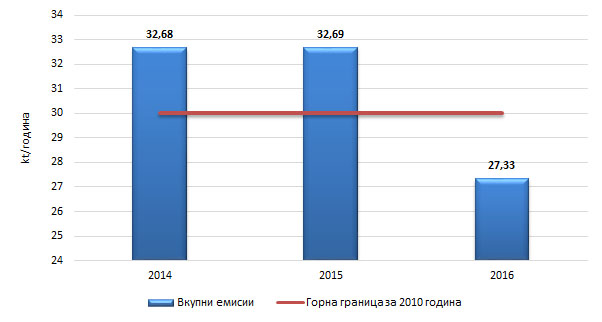 Older date protocol on non-methane volatile organic compounds also sets targets for this polluting substance, namely: Protocol to 1979 UNECE Convention on Long-Range Transboundary Air Pollution, concerning control of emissions of non-methane volatile organic compounds or their transboundary transfer, under which the national emissions of non-methane volatile organic compounds should be reduced by 30% relative to 1988 (this target was not achieved in 2014) which means that the country is compliant with this Protocol.
Older date protocol on non-methane volatile organic compounds also sets targets for this polluting substance, namely: Protocol to 1979 UNECE Convention on Long-Range Transboundary Air Pollution, concerning control of emissions of non-methane volatile organic compounds or their transboundary transfer, under which the national emissions of non-methane volatile organic compounds should be reduced by 30% relative to 1988 (this target was not achieved in 2014) which means that the country is compliant with this Protocol.
With reference to the targets-projections of NMVOCs for 2020 set in the Programme for gradual reduction of emissions of certain polluting substances at the level of the Republic of Macedonia, with reduction projections from 2010 to 2020, we should point out that those do not take into account recalculations for the emissions made for this polluting substance in the follow-up years and therefore review of projections for 2020 has been envisaged and those have not been taken into account in this report.
Legal basis
The Law on Ambient Air Quality adopted in August 2004 and amended several times afterwards (Official Gazette of RM no. 67/2004, 92/2007, 83/2009, 35/10, 47/11, 100/12, 163/2013,10/2015 и 146/2015) is framework law in the area of air. The goals of this Law include avoiding, prevention and reduction of harmful effects on human health and environment as a whole, prevention and abatement of pollutions leading to climate change, as well as provision of appropriate information on the quality of ambient air.
On the basis of the Law on Ambient Air Quality, 16 bylaws were prepared and adopted to introduce limit values for air quality and air emissions, methodology of air quality and air emissions monitoring, manner of preparation of planning documents for air protection against pollution, manner of informing the citizens and international organizations, etc.
In 2010, all 8 Protocols to the Convention on Long-Range Transboundary Air Pollution – CLRTAP were ratified. Owing to the requirement for amendment of the annexes with regard to emissions in the baseline year (1990) and national emission ceilings for 2010, the Gothenburg Protocol and 1995 Protocol on sulphur entered into force for the Republic of Macedonia in 2014 upon adoption of the values set in Annex II of these Protocols. In relation to the obligations for calculation of emissions of non-methane volatile organic compounds (NMVOCs), the following protocols or international ratified agreements are of relevance:
Protocol to 1979 Convention on Long-Range Transboundary Air Pollution concerning concerning control of emissions of non-methane volatile organic compounds or their transboundary transfer. The Protocol was ratified by the Law on Ratification (Official Gazette of RM no. 24/2010);
Protocol to 1979 Convention on Long-Range Transboundary Air Pollution concerning reduction of acidification, eutrophication and ground ozone (Gothenburg, 1999). The Protocol was ratified by the Law on Ratification (Official Gazette of RM no. 135/2010), while Republic of Macedonia became an equal member of the protocol in 2014
- Reporting obligations are set on annual level towards international agreements – UNECE-CLRTAP and ЕЕА
- Annual Report of Processed Data on Air Emissions
| Code | Title of the indicator | Compliance with CSI ЕЕА or other indicators | Classification by DPSIR | Type | Linkage with area | Frequency of publication | |
| MK NI 050 | Emissions of the main polluting substances – non-methane volatile organic compounds (NMVOCs) | EEA
UNECE |
CSI 040,
APE 010 A1/3 |
P | A |
|
annually |



















































